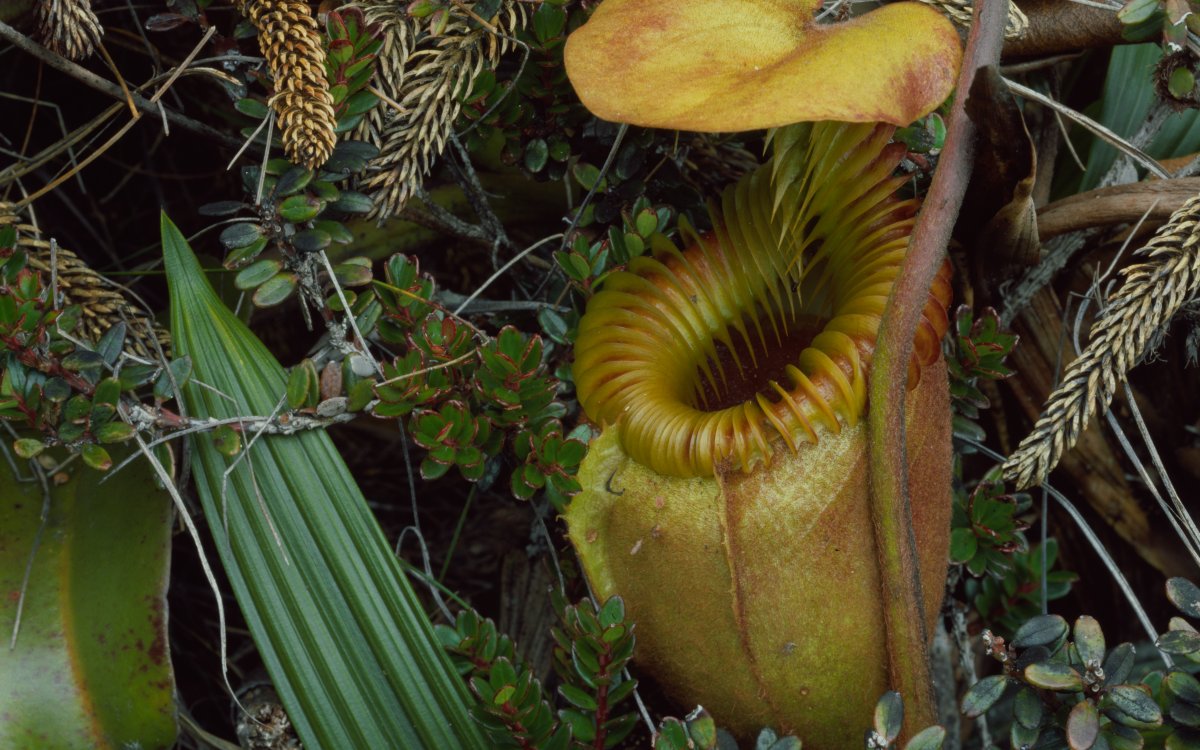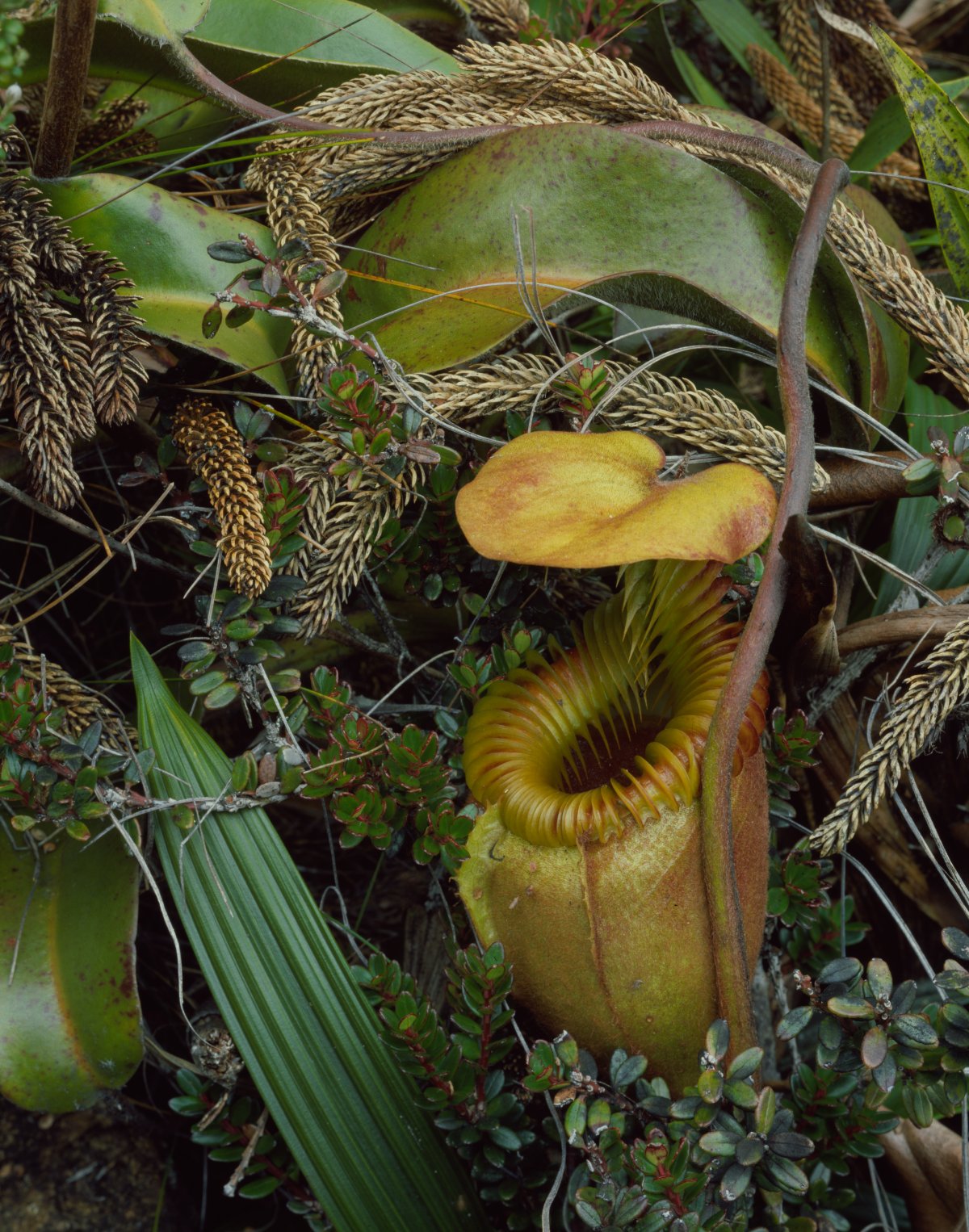Every living thing is part of a cycle. Plants and animals are born, they grow, they consume or produce, and they eventually die, making way for new life in their place. Without this cycle of life, ecosystems and the biosphere would not be able to survive.
Flora
The life cycle of plants can be completed in a matter of days or take many hundreds of years depending on the type of plant and the location in which it grows. Some plants complete their whole life cycle within a year, these are called ‘annuals’. Others take more than one season to grow, often over two or three years, these are called ‘perennials’. Large woody plants like trees and shrubs can take many years to mature and can live for centuries.

Dombrovskis, Peter, 1945-1996. (1986). Fallen hibiscus bloom at Cowie Bay, Greater Daintree, Queensland, 1986 [transparency] / Peter Dombrovskis. https://nla.gov.au/nla.obj-149059747

Dombrovskis, Peter, 1945-1996. (1989). Fern mosaic, Douglas River Gorge, east coast, Tasmania, 1989, 2 [transparency] / Peter Dombrovskis. https://nla.gov.au/nla.obj-149170600

Dombrovskis, Peter, 1945-1996. (1980). Cushion plants detail, Tasmania, 1980? [transparency] / Peter Dombrovskis. https://nla.gov.au/nla.obj-148520489
The oldest living tree on record is a Bristlecone Pine Tree, in the White Mountains, California, USA. The tree is estimated to be 5,067 years old, calculated by counting the growth rings taken from a core sample.
The oldest known tree in Australia is a Huon Pine in Tasmania. Core samples age this tree at around 2,000 years old.
The oldest living tree on record is a Bristlecone Pine Tree, in the White Mountains, California, USA. The tree is estimated to be 5,067 years old, calculated by counting the growth rings taken from a core sample.
The oldest known tree in Australia is a Huon Pine in Tasmania. Core samples age this tree at around 2,000 years old.
Many plants start their life as seeds, tiny pods of DNA encased in a protective shell. However, not all plants start their life like this. Some grow from spores, cells that have thick walls and can withstand harsh environments, while other plants grow from tubers (e.g., potatoes, taro, sweet potato), bulbs (e.g. tulips, daffodils, iris) or rhizomes (e.g. ginger, turmeric, bamboo). Regardless of their origin, plants of all types need nutrients to grow. As plants grow and their appetite increases, the spread their roots, leaves, stalks, and tendrils out to collect as much food as possible. Leaves spread and grow upwards to help plants catch the sun’s rays which they convert to energy, this is called photosynthesis. Plants like seaweed grow towards the surface of the water to be close to the sun. Roots collect water and food for the plant from the soil. Some plants even catch and eat animals to get the food they need. Australia is home to over 250 species of carnivorous plants. These plants typically catch insects by attracting them with sweet smells or vibrant patterns.

Dombrovskis, Peter, 1945-1996. (1986). Seed pods and leaves, Hinchinbrook Island, Queensland, 1986, 2 [transparency] / Peter Dombrovskis. https://nla.gov.au/nla.obj-149068887

Dombrovskis, Peter, 1945-1996. (1994). Uncoiling croziers of Dicksonia Antarctica, Pipeline Track, Mount Wellington, Tasmania, October 1994, 1 [transparency] / Peter Dombrovskis. https://nla.gov.au/nla.obj-148634261

Dombrovskis, Peter, 1945-1996. (1979). Feeder roots and mosses, Glen Calder, Franklin River, Tasmania, 1979 [transparency] / Peter Dombrovskis. https://nla.gov.au/nla.obj-148577652

Dombrovskis, Peter, 1945-1996. (1986). Rainforest near Cowie Bay, Greater Daintree, Queensland, 1986, 2 [transparency] / Peter Dombrovskis. https://nla.gov.au/nla.obj-148816781

Dombrovskis, Peter, 1945-1996. (1994). Buttressed trees, Fiji, 1994 [transparency] / Peter Dombrovskis. https://nla.gov.au/nla.obj-150287151

Dombrovskis, Peter, 1945-1996. (1985). Pitcher plant (Nepenthes villosa) at 3,200m on Mount Kinabalu, Borneo, 1985 [transparency] / Peter Dombrovskis. https://nla.gov.au/nla.obj-149683265
As trees grow, they shoot branches and produce canopies of leaves. Many plants and trees also produce flowers. Flowers can be beautiful to look at and smell, but they have a key role in the life cycle of the plant. Flowers provide plants with a way of reproducing. Flowers can contain pollen which is needed to fertilise other plants. Birds and insects, like bees, help to transfer pollen from one plant to another
When plants die, their trunks and branches provide shelter and food for animals and insects. Depending on the environment, fallen trees will provide an opportunity for moss, fungi, and other plants to sprout. Eventually, the plant will be broken down by decomposers, returning nutrients and minerals to the soil so that future plants can have food and energy as they grow.

Dombrovskis, Peter, 1945-1996. (1993). Weather-bleached deciduous beech, Cradle Mountain-Lake St Clair National Park, Tasmania, 1993 [transparency] / Peter Dombrovskis. https://nla.gov.au/nla.obj-148961923

Dombrovskis, Peter, 1945-1996. (1990). Sassafras trees in mist, Mount Anne, southwest Tasmania, 1990, 1 [transparency] / Peter Dombrovskis. https://nla.gov.au/nla.obj-148933628

Dombrovskis, Peter, 1945-1996. (1995). Strangler fig in Yidney scrub, Fraser Island, Queensland, 1995 [transparency] / Peter Dombrovskis. https://nla.gov.au/nla.obj-149021207

Dombrovskis, Peter, 1945-1996. (1985). Leaf skeleton at Mount Mulu, Sarawak, Malaysian Borneo, 1985 [transparency] / Peter Dombrovskis. https://nla.gov.au/nla.obj-149055787

Dombrovskis, Peter, 1945-1996. (1979). Franklin River above Collingwood Junction, southwest Tasmania, 1979 [transparency] / Peter Dombrovskis. https://nla.gov.au/nla.obj-150392978
Fauna
The life cycle of animals is like that of plants in that the span of time it takes to complete a cycle varies greatly. Insects have some of the shortest life spans of any creature. Certain species of Mayfly are born, lay eggs and die all within the space of an hour. Some others live only for a few days or weeks.
In most cases, the longer and animal takes to mature the longer they will live. Among the longest living land animals are reptiles. Typically, slow to grow and mature, large reptiles can take up to 20 years to reach a stage of their life where they can lay eggs and produce young. There are tortoises who are recorded as being more than 200 years old when they died. Harriet, a tortoise thought to have been collected by Charles Darwin on a visit to the Galapagos Islands in 1835, died in Australia in 2006 and was estimated to be between 150-255 years old.

Dombrovskis, Peter, 1945-1996. (1984). Royal penguin rookery, Macquarie Island, Tasmania, 1984, 3 [transparency] / Peter Dombrovskis. https://nla.gov.au/nla.obj-150531124

Dombrovskis, Peter, 1945-1996. (1990). Yabbie, Mount Anne, Southwest National Park, Tasmania, 1990 [transparency] / Peter Dombrovskis. https://nla.gov.au/nla.obj-150974279

Dombrovskis, Peter, 1945-1996. (1984). Elephant seals, Macquarie Island, Tasmania, 1984, 12 [transparency] / Peter Dombrovskis. https://nla.gov.au/nla.obj-151159145

Dombrovskis, Peter, 1945-1996. (1984). Albatross chick, Macquarie Island, Tasmania, 1984 [transparency] / Peter Dombrovskis. https://nla.gov.au/nla.obj-151183267

Dombrovskis, Peter, 1945-1996. (1976). Rufus wallaby, Cradle Mountain-Lake St Clair National Park, Tasmania, 1976? [transparency] / Peter Dombrovskis. https://nla.gov.au/nla.obj-151337585

Dombrovskis, Peter, 1945-1996. (1986). Spiderweb detail, Cradle Mountain, Cradle Mountain-Lake St Clair National Park, Tasmania, 1986? [transparency] / Peter Dombrovskis. https://nla.gov.au/nla.obj-151194004
Australia is home to the largest living reptile, the Saltwater Crocodile. Saltwater crocodiles hatch from eggs like other reptiles and mature around the age of 16 for males and 14 for females. Once a saltwater crocodile reaches adulthood, they have no natural predators and can live to around 70 years in the wild.
Animals, like plants, play a key role in the ecosystems in which they live. Throughout their life they provide food for other animals, feed on other animals which balances populations, clean the environment by scavenging plants and animals that have died and can help plants grow by transporting and burying seeds while digging for food and by fertilising the ground with their droppings. When they are mature, most animals produce and nurture their young ensuring they have the best chance to grow into adults. However, some animals never meet their young. When an animal dies, their bodies provide food and nutrients for the plants and animals around them.

Dombrovskis, Peter, 1945-1996. (1991). Wallaby skeleton, Tasmania, 1991? [transparency] / Peter Dombrovskis. https://nla.gov.au/nla.obj-150959985

Dombrovskis, Peter, 1945-1996. (1989). Wallaby skull and pencil pine leaves, Tasmania, 1989? [transparency] / Peter Dombrovskis. https://nla.gov.au/nla.obj-150974673

Dombrovskis, Peter, 1945-1996. (1974). Bleached whale bones, Maria Island, Tasmania, 1974? [transparency] / Peter Dombrovskis. https://nla.gov.au/nla.obj-151261904

Dombrovskis, Peter, 1945-1996. (1974). Whale vertebrae, south coast, Tasmania, 1974? [transparency] / Peter Dombrovskis. https://nla.gov.au/nla.obj-151338236
Activities
- All plants and animals have a life cycle in which they are born, mature, reproduce and die. This cycle is more obvious in some animals than others like amphibians and insects.
- Ask the students to write a creative story from the point of view of an animal as it transitions through the stages from birth to adulthood. Writing prompts may include:
- How might a young tadpole react to one day finding it had legs growing.
- How would a hungry caterpillar feel about its growing urge to spin a cocoon.
- How curious might a baby bird be to break through the eggshell and see the world outside?
- Ask the students to write a creative story from the point of view of an animal as it transitions through the stages from birth to adulthood. Writing prompts may include:
Prompt the students to use descriptive language to tell of the animal and its surrounds and how it changes.
- Plants are some of the longest living things on Earth. Trees can be dated by the rings in their trunk. However, this usually means cutting down a tree to find out this information, killing the tree. However, some trees fall naturally, or sometimes branches are trimmed to protect the tree.
- Scout the school yard (or teachers could bring in examples) for tree stumps, branches with clean cross-sections or fallen trees. Looking closely, can the rings in the wood be made out (sometimes wetting the wood can help). How old are they trees?
- Scout the school yard (or teachers could bring in examples) for tree stumps, branches with clean cross-sections or fallen trees. Looking closely, can the rings in the wood be made out (sometimes wetting the wood can help). How old are they trees?
- Composting is a process whereby organic material is broken down to extract the nutrients and minerals from the original material for use in providing for other living organisms. Composting is common in-home gardens and is an excellent way to clean up material like fallen leaves or grass clippings. The process used by gardeners is the same as the natural process of decomposition, but it is usually sped up by the process of collecting material in one spot and keeping it in containers or locations with specific heat/light/shelter.
- Where appropriate, start a small school compost collection. Collect clipped grass or fallen leaves and add to the pile. Over time, observe how the material breaks down. If your school already has a vegetable garden and or a compost pile, work with the staff responsible for the garden to involve students in the process of collecting, digging in and observing the change in the material.























